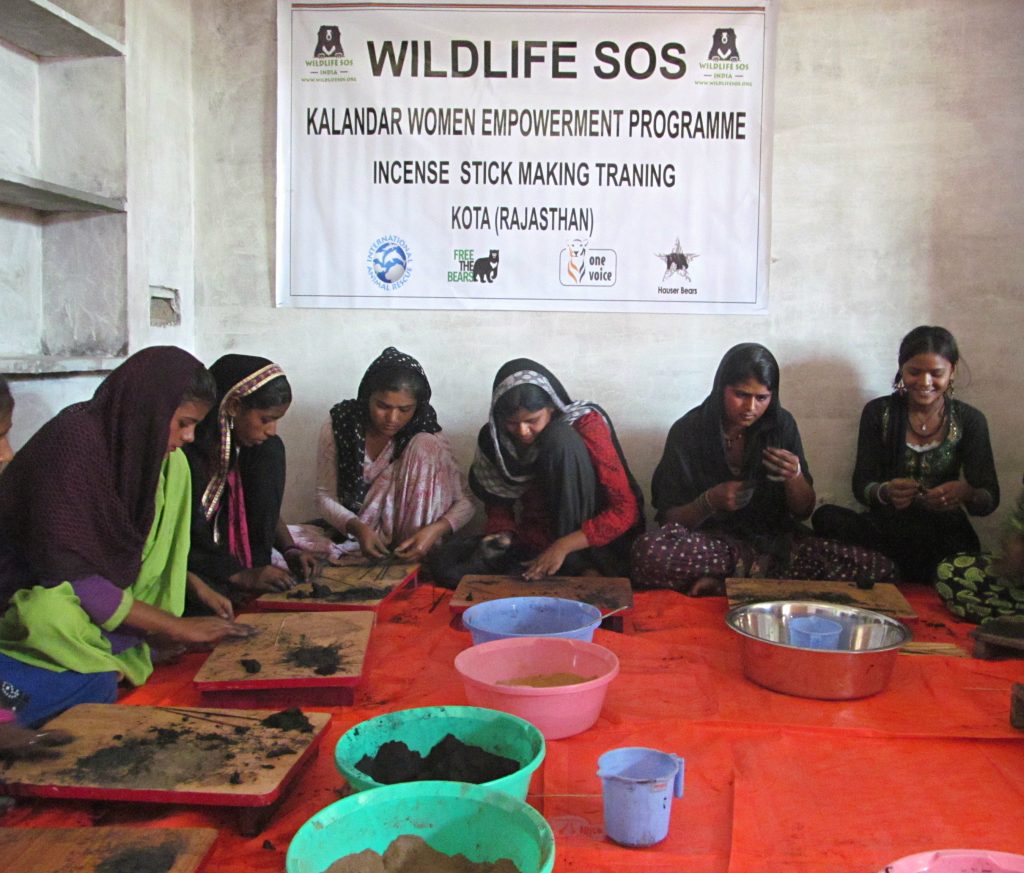A young family of three enjoys a delightful meal on an uncommonly warm fall day in one of Armenia’s many outdoor restaurants. A doting father leans playfully across the table to poke a fork at his cherub-like son. The child’s mother looks on lovingly. It’s a scene that would be the stuff of tourist brochures—were it not for its disturbing backdrop.
Visible from the family’s table is a wild brown bear, hovering despondently in the backdrop, pacing the length of its rusty cage to and fro, just meters from the happy family on the other side of the river.

The Daily Mail article released photographs of a family of three dining at the riverside restaurant where the captive bears are featured in the backdrop. When the article was first released, the faces were visible. Given the incendiary nature of the article, they have since been blurred. (Photo: Roger Allen/Silverhub/REX/Shutterstock)
These photographs make up part of an exposé recently published in the UK tabloid Daily Mail. They’re accompanied by provocative captions describing the family as “oblivious” and the scene as “heartbreaking.” Within days, the article was shared thousands of times on social media.
The reaction from the international community was visceral. One angry commenter wrote, “How about they put the diners in a cage instead let them live the experience of the bears?” The faces of family members dining in the image, previously visible, have since been blurred.
Within a week after the article was published, a rescue mission was carried out by a UK-based nonprofit called International Animal Rescue (IAR); its CEO, Alan Knight, called on the international community to help fund the mission (see his video, below).
[youtube https://www.youtube.com/watch?v=Vlm9ka7Qkfg]
The bears, Dasha and Masha, who had spent a decade confined to this cage, were cut free and transported to a mountaintop sanctuary in the village of Urtsadzor with the help of Armenian Emergency Rescue service members.
Representatives from IAR are being assisted locally by the Foundation for Wildlife and Cultural Heritage (FPWC) organization, which has been working to save captive bears in Armenia since 2010. A press statement from IAR indicates that the Armenian government is in full support of the operation.

The restaurant’s owner, Shushik Mkrtchyan, watches as the bears are taken away. (Photo: International Animal Rescue)
The recent rescue operation in Armenia is the second in what will be a series of missions called The Great Bear Rescue, an international campaign that has garnered support from celebrities such as actors Neil Morrissey and Peter Egan. The first rescue operation—also occasioned by a piece in the Daily Mail—took place in Jan. 2016 in the city of Gyumri, where a private zoo had been holding three lions, two guinea pigs, and two bears in abhorrent living conditions.
This isn’t the first time IAR has embarked on a large-scale mission to save bears in a foreign country. In 2002, it began working in India, hoping to end the gruesome practice of bear dancing, which had been persistent in the country for hundreds of years. IAR worked with a local organization on the ground to convince a historic community of bear charmers (kalandars) to willfully surrender their bears. It was a long-term project that required new economic prospects be found for the impoverished community of kalandars, who relied on the bears for their livelihood; by 2009, the last dancing bear in India had been rescued.

One of the trainings for the local kalandar (bear-charmer) community in India, implemented by Wildlife SOS (Photo: Wildlife SOS)
IAR’s initiative in Armenia will be focusing solely on the welfare of bears rather than providing preventative measures as in the case of India. Its campaign information states that 4,000 euros are being raised to fund rescue missions and 75,000 will go toward a new bear sanctuary.
In analyzing why the practice of keeping captive bears as idle entertainment still exists in Armenia, many critics have pointed to the government’s passive stance on the issue. International pressure, however, has been useful in initiating action. After the first rescue operation was publicized in 2016, animal rights activists grew hopeful when members of Armenia’s Parliament and the scientific community finally began to redraft a law on wildlife that would put an end to bear captivity in Armenia. The draft is still being finalized.
But even when bear dancing was outlawed in India in 1972, the practice persisted for another 30 years—and actually ended only when social factors regarding the kalandar community were taken into consideration.
“The number-one challenge,” says FPWC Environmental Program Coordinator Arevik Mkrtchyan, who is involved with the IAR-assisted bear rescues, “is to educate people and raise awareness so that such attitudes change here locally and people do not find it fun to see a bear kept in a cage in a restaurant or resort area.”
“In ancient times, Armenian kings and lords were holding wild animals in their palaces and private premises, which they were chasing during hunting in forests and mountains,” she explained in one interview. “Back then, this was a sign of power and mercy, as the hunted animals were not killed during the hunt but were gifted life as a result of the King’s generous action.”
Though Armenia is culturally modern in many ways, the feudal gesture of wealthy individuals’ holding exotic animals hostage remains. The country’s rapid industrialization as a Soviet republic, where businesses were nationalized and farmers were stripped of their land, may also have had a disenfranchising effect between Armenians and their local environment.

This photo was taken at the restaurant Ashtaraki Dzor in Armenia, where several bears are being held in captivity. These same bears mauled a young woman’s hand last summer when she tried to pet one through its cage. (Photo: Gacia Demirdjian/The Armenian Weekly)
I witnessed the plight of brown bears in Armenia firsthand back in 2015, when I attended a wedding at a venue called Ashtaraki Dzor. In the restaurant’s outdoor dining area, we were shocked to discover, was a private “zoo”—much like the one in the article that made headlines—in which several bears were being held captive. Last June, those same bears made headlines—not for the shocking conditions in which they were living, but for reportedly mauling the hand of a 23-year-old woman attempting to pet them.
Many underlying narratives lurk below the surface of the disturbing practice of bear captivity in Armenia. What will saving the bears do to address those issues? What happens after IAR’s work in the country is done? And as a people who have inhabited this land and have interacted with its nature continuously for millennia, how will Armenians begin re-establishing the relationship between modern citizens and the natural world?
Note: The slideshow at the beginning of this article features images from the Oct. 31 rescue of the two bears Masha (light) and Dasha (dark) from Home Of The Bears in Yerevan, Armenia. The veterinarian in the red trousers is Rosa Jolma, who was sent by International Animal Rescue. IAR was assisted by team members from Armenian Emergency Rescue services and FPWC.
The post Can Freeing Captive Bears in Armenia End the Attitudes That Imprisoned Them? appeared first on The Armenian Weekly.
Source: Armenian Weekly
Link: Can Freeing Captive Bears in Armenia End the Attitudes That Imprisoned Them?
